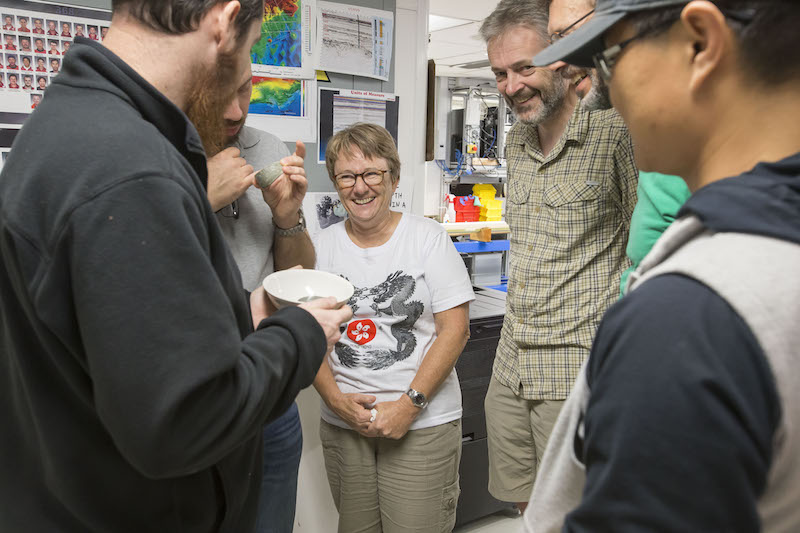
Kelsie Dadd – Sedimentologist – Scientist interview!
One of the things that I get to do on this expedition is get to know the scientists. Their curiosity and tenacity for understanding how the world works is what gives purpose to these expeditions. It was my extreme pleasure to sit down with Kelsie Dadd a couple of days ago and find out a bit more about her and why she is on Expedition 368.
We are on different shifts so we are passing in the night or at noon when we see each other. When I see Kelsie I notice is that she is always in the mix, engaged, and talking with her team mates. Getting to speak with her about her work as a scientist was inspiring. It is easy to see that her perspective is both broad and deep on the importance of the work in the South China Sea Rifted Margin and for the future of science.
Can you tell us a little bit about yourself and your role here on the JOIDES Resolution?
My name is Kelsie Dadd, and at the moment I’ve got 2 positions at home: I’m an honorary associate at Sidney University and I also work 1 day a week with a program called Curious Minds. Curious Minds is a government funded program and we are trying to inspire young girls to become scientists.
Here on the ship, I am one of the core describers and I am working as a Sedimentologist. My background is in Volcanology so I studied very old volcanic rocks and sediments that surround them.
This is my third expedition with IODP. I went in 2009 to the Bering Sea, which was very exiting. Then, I was on Expedition 349 that was here to the South China Sea. So this expedition has a slightly different theme, but we are still targeting that old basalt.
You’re here working under the scientific prospectus for Expedition 368, can you tell us why we’re here for this expedition?
We’re here to discover what the nature of the continental ocean transition is. I’ve been teaching geoscience for about 20 years, and when you talk to students about continental crust and oceanic crust you tend to draw this picture of the continental crust as this sort of fuzzy line and it just merges into oceanic crust. But it’s never really well defined and we don’t always understand what that boundary is and how it differs in different margins when you get that transition from continent to oceans. So what we’re doing here is drilling a sequence of holes across the margin to better understand how that whole rifting and break up occurs.
What are your own personal research interests?
There are a number of volcanoes that are around the South China Sea, in particular near the Philippines, and when they erupt their ashes spread quite widely – a lot of which will fall into the South China Sea. That ash is collected within sediment as little layers. I’m interested in that ash. I have some collected from Expedition 349, and I want to add to that collection to deepen my understanding of the distribution of the ash and also its chemistry. The chemistry helps me identify which volcano the ash may have come from. With this information, I can look at a history profile of eruptions through time and I can also get a time record of the basin. The ash layer that erupts from a volcano should be basin-wide, so we should be able to pick that up in each of the drill holes and use it as a basin-wide marker.
How did you decide to study volcanoes?
My high school teacher. I was lucky enough to be able to take Geology as a subject in high school. I had a teacher that was just fascinated by Geology and she was so enthusiastic that it just spilled over to me. It was actually plate tectonics, very much what we’re doing out here, to find that there was a way of relating all the different aspects of the way the Earth works – I just found that fascinating.
Do you have any advice for young scientists thinking about going into this field?
For high school students, I would say: follow your passion. You’ll hear from a lot of career advisors that you need to go into a job that makes you lots of money. So, we see people going into law and medicine and finance. And maybe that’s not really what they want to do. You’ll be working in that field for the majority of your life, so I think it’s important to follow an interest that you’re passionate about.
Why is studying plate tectonics important?
We need to know how the Earth works, particularly about ocean basins which make up a huge part of the Earth. We need to understand the natural system so we know how climate changes, how to make predictions in the future, and to understand how we are affecting it.